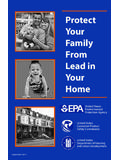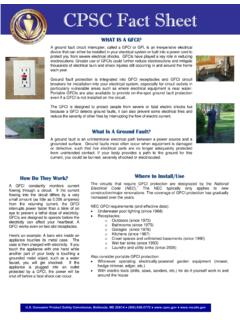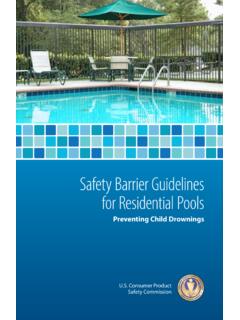Transcription of Test Method: CPSC-CH-E1003-09.1 Standard Operating ...
1 UNITED STATES CONSUMER PRODUCT SAFETY COMMISSION DIRECTORATE FOR LABORATORY SCIENCES DIVISION OF CHEMISTRY Test Method: Standard Operating Procedure for Determining Lead (Pb) in Paint and Other Similar Surface Coatings* February 25, 2011 This document provides information on the test methodology that is used by the Consumer Product Safety Commission s (CPSC) Product Testing Laboratory, Chemistry Division (LSC), in the analysis of paint and certain painted products. The methodology is used to determine the total lead content of paint, or a painted surface, on a dry paint basis. This method supersedes all previously published Standard Operating procedures for lead in paint testing.
2 CPSC staff has concluded that this test methodology is sufficient to make appropriate determinations concerning lead (Pb) in paint, as defined in 16 Part1303, with a regulatory limit of by weight. Adjustments may be necessary to achieve total digestion for certain paints, and should be based on sound chemistry knowledge and appropriate acids for the sample material being analyzed. Screening tests by X-ray fluorescence may sometimes be employed by CPSC staff to determine samples in need of such testing. Definitions 1. Sample an individual consumer product or a group of identical consumer products from a batch to be tested 2.
3 Component Part individual sub-unit within the total sample. Each separate paint color on a sample is a component part. 3. Composite Testing-like parts combining like paints from several like parts or products to obtain sufficient sample size for analysis when there is insufficient quantity of paint on one item to perform testing. 4. Composite Testing-different parts combining different paints ( , multiple colors) from one or more samples to reduce the number tested. 5. Instrument Detection Limit (IDL) 3 times the Standard deviation of 10 replicate measurements of reagent blank. 6. Method Detection Limit (MDL) reagent blank fortified with 2-3 times the IDL.
4 Seven replicate measurements are made. Calculate the MDL as follows: MDL = t X S, t = (99% confidence level for 7 replicates), S = Standard deviation. * This document was prepared by CPSC staff, has not been reviewed or approved by, and may not necessarily reflect the views of, the Commission. -2- 7. Laboratory Reagent Blank (LRB) an aliquot of the digestion reagents that is treated exactly as a sample including exposure to glassware, digestion media, apparatus, and conditions used for a particular Pb test, but with no added sample. LRB data are used to assess contamination from the laboratory environment.
5 8. Calibration Blank deionized water acidified with nitric acid (3 ml concentrated nitric acid diluted to 100 ml with deionized water). 9. Stock Standard Solution 1000 g/ml solution of Pb purchased from reputable commercial source, used to prepare calibration standards. Replace before expiration date. 10. Calibration Standards solutions containing 0 to 25 g/ml of Pb in 3% nitric acid matrix are used. A minimum of 4 calibration standards are used. Calibration standards should be prepared weekly. 11. Quality Control Sample (QCS) a solution containing Pb that is used to evaluate the performance of the instrument system.
6 QCS is obtained from a source external to the laboratory and Stock Standard Solution. 12. Certified Reference Material (CRM) CRMs are materials with similar matrices as test samples with known lead levels. The CRMs are used to verify digestion and analysis methods . For example, Standard reference materials (SRMs) are CRMs that are available from the National Institute of Standards and Technology (NIST), such as those listed in the Equipment and Supplies section below. Equipment and Supplies: The materials used for sampling and analysis are as follows: 1. Nitric acid, trace metal grade 2. Disposable plastic digestion vessels, 50 ml, or glass test tubes 3.
7 Hot block digester or hot plate with test tube block 4. Disposable razor blade or scalpel 5. Methylene chloride (optional) 6. Distilled water 7. Microwave digestion apparatus 8. CRMs such as NIST SRMs1 2581 and 2582 lead in powdered paint. CRMs such as NIST SRM 2569 that are paint films should be used if X-ray fluorescence spectroscopy methods conducted 9. Internal Standard (such as yttrium, from a stock Standard solution of that element appropriate to the instrument parameters of the ICP used for the analysis) Note on composite testing: Composite testing-like parts (as defined above) is appropriate and may be necessary to obtain valid analytical results.
8 Composite testing-different parts (as defined above) must be done with adequate care, planning, and understanding of the limitations and propagations of error in measurements or the test may fail to detect excessive lead in one individual paint because of dilution. If composite testing-different parts is used, great care must be taken to accurately weigh each component paint and account for the propagation of errors due to weighing and measuring, and the analyst must ensure that the compositing will not result in a Pb measurement being below the detection limit for a paint component that would exceed Pb. 1 NIST SRMs 2581 and 2582, and other reference materials, are available from the National Institute of Standards and Technology.
9 See -3- Each individual paint must be weighed individually with sufficient precision and sufficient safety factors to assure that no false negatives are reported. Sufficient paint must be used for each of the paints giving proper consideration for the weighing capabilities of the balance used and the detection limits and necessary dilution for the subsequent instrumental analysis. The combined paints could then be digested according to the procedure given below for a single paint, before analysis by inductively coupled plasma (ICP) spectroscopy. Appropriate weights for each of the individual paints that are composited depend on final dilution volumes, weighing accuracy, and detection limits.
10 All of the lead found in the digestate for the combined composite could be attributed to the weight of each of the individual paints as though all of the lead could possibly come from any one of the individual paints. The measured lead should be treated in calculations as if it originated solely from one part of the composite; the lead concentration calculation should be carried out for each part unless identical weights of each sample were used in the analysis. An example is given at the end of this document. In considering results from such a composite sample, it is imperative that a sufficient safety factor be applied to account for weighing inaccuracy and propagation of errors from each step in the analytical procedure to ensure no violative paints are misrepresented as nonviolative.









